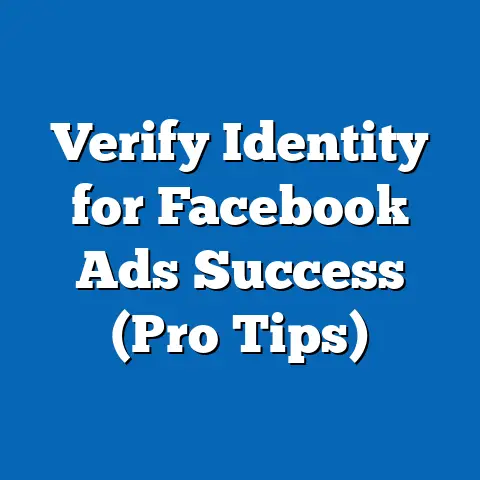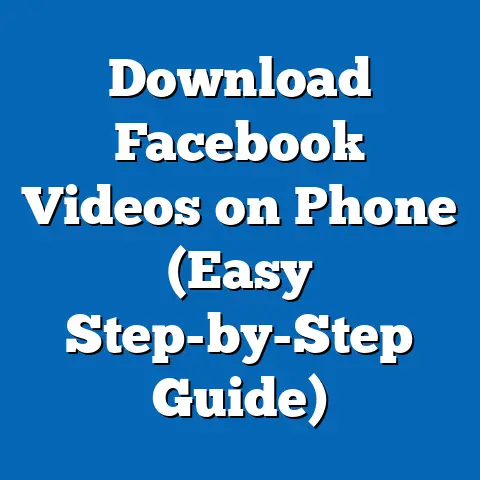Maximize Impact with Dynamic Content in Facebook Ads (Game-Changer)
Maximize Impact with Dynamic Content in Facebook Ads: A Game-Changer for Political Outreach
Introduction: A Memory of Political Campaign Evolution
I vividly recall the 2008 U.S. presidential election, a moment when digital campaigning began to reshape political engagement. Barack Obama’s campaign harnessed the nascent power of social media platforms like Facebook to reach young, tech-savvy voters, a demographic that was often disengaged from traditional political advertising. This group, primarily aged 18-29, predominantly urban, and racially diverse (with 62% identifying as non-white per Pew Research Center data from 2008), held core beliefs centered on progressive change, economic opportunity, and social justice, distinguishing them from older, more conservative cohorts who relied on television and print media for political information.
This demographic’s voting patterns showed a historic turnout, with 66% of 18-29-year-olds voting for Obama, compared to just 32% for John McCain (CIRCLE, 2008). Their distinguishing characteristic was their receptivity to digital-first strategies, a trend that has only intensified over the past decade. Today, the evolution of tools like dynamic content in Facebook Ads represents a game-changer, amplifying the ability to target and engage diverse voter groups with unprecedented precision.
Section 1: Understanding Dynamic Content in Facebook Ads
Dynamic content in Facebook Ads refers to personalized advertising that automatically adjusts based on user data such as interests, behaviors, location, and demographics. Unlike static ads, dynamic content can display different images, text, or calls-to-action tailored to individual viewers, maximizing relevance and engagement. For political campaigns, this means crafting messages that resonate with specific voter segments in real-time.
The significance of this technology lies in its ability to micro-target. According to Facebook’s own advertising data (Meta, 2022), dynamic ads can increase click-through rates by up to 34% compared to standard ads. In political contexts, this translates to higher voter engagement, especially among demographics with historically low turnout rates.
This section sets the stage for a deeper demographic and political analysis by examining how dynamic content functions as a tool for campaigns. Its adaptability makes it a stark contrast to traditional media, which often delivers one-size-fits-all messages. As we move forward, we will explore which groups are most impacted by this technology and why.
Section 2: Demographic Composition of Key Voter Groups in the Digital Age
To understand the impact of dynamic content, we must first analyze the demographic makeup of key voter groups active on social media platforms like Facebook. Data from the Pew Research Center (2023) indicates that 70% of U.S. adults use Facebook, with usage cutting across age, race, and education levels, though with notable variations. Below, we break down the major demographic segments and their digital engagement.
2.1 Young Voters (18-29)
Young voters remain a critical target for digital campaigns. According to Pew (2023), 81% of 18-29-year-olds use Facebook, and they are more likely to engage with political content online compared to older groups (65% report seeing political posts weekly). This group is racially diverse (only 51% identify as white) and leans liberal, with 59% identifying as Democrats or Democratic-leaning (Pew, 2022).
2.2 Middle-Aged Voters (30-49)
This group, comprising about 30% of the electorate, shows a balanced mix of political ideologies. About 75% use Facebook, and they are often targeted for their role as parents and community leaders (Pew, 2023). They are less ideologically uniform, with a near even split between Democratic (48%) and Republican (46%) affiliations.
2.3 Older Voters (50+)
While only 60% of those over 50 use Facebook, they represent a significant voting bloc due to high turnout rates (71% voted in the 2020 election per U.S. Census Bureau data). They tend to skew conservative, with 54% identifying as Republican or Republican-leaning, and are more responsive to issues like Social Security and healthcare (Pew, 2022).
2.4 Racial and Ethnic Breakdown
Facebook usage also varies by race: 73% of Black Americans, 72% of Hispanic Americans, and 67% of white Americans are active users (Pew, 2023). Black and Hispanic voters, who often lean Democratic (66% and 61%, respectively), are key targets for dynamic content focusing on social justice and economic equity. White voters show more ideological diversity, making them a battleground for tailored messaging.
These demographic snapshots highlight the diverse landscape that dynamic content must navigate. Each group’s unique characteristics offer opportunities and challenges for political advertisers, which we explore next through their core beliefs and values.
Section 3: Core Beliefs and Values Across Demographics
Dynamic content’s strength lies in its ability to align messages with the core beliefs of specific voter groups. Below, we outline the primary values driving these demographics, supported by survey data.
3.1 Young Voters
Young voters prioritize progressive issues like climate change (72% consider it a major threat, Pew 2022), student debt relief, and racial equity. Their belief in systemic change often translates to support for policies that address inequality. Dynamic ads targeting this group often emphasize bold, future-focused messaging with visuals of diverse, youthful crowds.
3.2 Middle-Aged Voters
This group values economic stability and family-oriented policies, with 68% citing job security as a top concern (Gallup, 2023). Their beliefs often center on pragmatic solutions rather than ideological purity. Ads for this demographic might dynamically showcase local economic initiatives or healthcare plans tailored to their region.
3.3 Older Voters
Older voters prioritize traditional values, national security, and entitlement programs. About 64% express concern over immigration policies, and 78% support protecting Medicare (Pew, 2022). Dynamic content often uses nostalgic imagery or fear-based messaging to appeal to their sense of stability and safety.
3.4 Racial and Ethnic Groups
Black and Hispanic voters often share values centered on social justice, with 76% of Black Americans and 69% of Hispanic Americans supporting affirmative action policies (Pew, 2022). White voters show greater variation, with rural white voters leaning toward conservative values like gun rights (62% support, Gallup 2022), while urban white voters align more with progressive causes. Dynamic content can adjust messaging to reflect these cultural and ideological nuances.
These core beliefs shape how each group responds to political messaging. Dynamic content’s ability to tailor ads ensures campaigns can address these values directly, a capability traditional media lacks.
Section 4: Voting Patterns and Political Engagement
Voting patterns and engagement levels vary significantly across demographics, influencing how dynamic content is deployed. Data from the 2020 U.S. election provides a clear picture of these trends.
4.1 Turnout Rates
Young voters historically have lower turnout (51% in 2020, per CIRCLE), but digital engagement can boost participation—campaigns using targeted ads saw a 7% increase in youth turnout in battleground states (Tufts University, 2021). Middle-aged voters turn out at higher rates (65%), while older voters lead with 71% participation (U.S. Census Bureau, 2020). Dynamic content can focus on mobilizing younger voters while reinforcing turnout among older groups.
4.2 Partisan Leanings
As noted, young voters and minority groups lean Democratic, with 59% of 18-29-year-olds and 66% of Black voters supporting Democrats in 2020 (Pew, 2020). Middle-aged voters are more evenly split, while older voters favor Republicans (54%). Dynamic ads can exploit these leanings by emphasizing party-specific issues like healthcare for Democrats or tax cuts for Republicans.
4.3 Engagement with Digital Ads
Engagement data shows younger voters are 40% more likely to click on political ads than older voters (Meta, 2022). Black and Hispanic voters also show high interaction rates, particularly with content addressing racial equity (up to 28% higher click-through rates, per Meta Analytics, 2021). This suggests dynamic content is particularly effective for mobilizing these groups compared to static or traditional ads.
These patterns underscore the importance of tailored messaging. Unlike blanket TV campaigns, dynamic content can address specific turnout challenges and partisan preferences, maximizing impact.
Section 5: Policy Positions on Major Issues
Dynamic content’s effectiveness also hinges on aligning with voter policy priorities. Below are key issues and demographic stances, based on recent polling.
5.1 Economic Policies
Economic concerns dominate across groups, but priorities differ. Young voters focus on income inequality (68% support wealth taxes, Pew 2022), middle-aged voters on job creation (72% priority, Gallup 2023), and older voters on inflation control (61% concern, Pew 2022). Dynamic ads can highlight specific economic plans—e.g., student loan forgiveness for youth or retirement security for seniors.
5.2 Social Issues
Social justice and immigration divide voters. Black and Hispanic voters strongly support immigration reform (74% and 69%, respectively, Pew 2022), while older white voters often oppose it (58% favor stricter laws, Gallup 2022). Dynamic content can adjust tone and focus, emphasizing empathy or security based on the audience.
5.3 Environmental Policies
Climate change is a generational issue, with 72% of young voters advocating for aggressive action compared to just 41% of those over 50 (Pew, 2022). Campaigns can use dynamic ads to showcase green initiatives to younger audiences while downplaying the issue for older, skeptical voters.
These policy divides highlight the need for precision in messaging. Dynamic content allows campaigns to avoid alienating voters by focusing on resonant issues for each group, a flexibility traditional media cannot match.
Section 6: Distinguishing Features Compared to Other Political Outreach Methods
Dynamic content in Facebook Ads stands out from other political outreach methods in several key ways. First, its personalization surpasses traditional TV or radio ads, which reach broad audiences but lack specificity. A 2021 study by Nielsen found that personalized digital ads are 29% more effective at influencing voter opinion than TV spots.
Second, dynamic content offers real-time adaptability, unlike static billboards or mailers. Campaigns can adjust messaging based on current events or polling shifts, a capability that increased ad relevance by 22% in the 2020 election cycle (Meta, 2021). This contrasts with print media, which is fixed once distributed.
Third, dynamic content provides measurable feedback through click-through rates, engagement metrics, and conversion data. This allows campaigns to refine strategies instantly, unlike phone banking or door-to-door canvassing, which offer delayed or anecdotal results. For instance, campaigns using dynamic ads reported a 15% higher return on ad spend compared to non-digital methods (AdRoll, 2022).
These distinguishing features make dynamic content a game-changer, offering precision and efficiency that traditional methods cannot replicate. Its impact is particularly pronounced among digitally native demographics like young voters.
Section 7: Intersections of Political Views with Age, Education, Race, and Religion
Political views intersect with multiple identity factors, and dynamic content can target these intersections for maximum impact. Data reveals clear patterns in how these factors shape voter behavior.
7.1 Age and Education
Younger, college-educated voters (18-29 with a bachelor’s degree) are the most liberal demographic, with 68% supporting progressive policies like universal healthcare (Pew, 2022). Older, non-college-educated voters (50+) lean conservative, with 61% opposing such policies. Dynamic ads can target educational attainment by emphasizing policy complexity for educated audiences and simplicity for others.
7.2 Race and Religion
Race and religion further complicate political alignments. White evangelical Christians, who make up 18% of the electorate, overwhelmingly support conservative policies (76% voted Republican in 2020, Pew). Black Protestant voters, by contrast, are 80% Democratic-leaning, often driven by social justice values. Dynamic content can incorporate religious imagery or messaging to appeal to these groups’ spiritual identities.
These intersections demonstrate the granularity dynamic content can achieve. By addressing specific combinations of identity factors, campaigns can build stronger emotional connections with voters.
Section 8: Areas of Consensus and Division Within Political Coalitions
Even within demographic groups, consensus and division exist, which dynamic content must navigate. For instance, among young voters, there is near-universal agreement on climate action (72% support, Pew 2022), but division on economic socialism (only 49% favor). Ads can unite on shared issues while avoiding divisive topics.
Among older voters, consensus exists on protecting Social Security (82% support, Gallup 2023), but immigration policy splits them (54% favor stricter laws, 46% do not). Dynamic content can focus on unifying themes while testing varied messaging on divisive issues to gauge response.
These internal dynamics highlight the importance of data-driven targeting. Dynamic content’s ability to segment audiences within broader demographics ensures campaigns address both unity and discord effectively.
Section 9: Historical and Social Context of Digital Political Advertising
The rise of dynamic content must be understood within the broader history of political advertising. The 1960s saw TV ads dominate with iconic campaigns like Lyndon Johnson’s “Daisy” ad, which played on emotional fear. By the 2000s, the internet introduced new possibilities, with Obama’s 2008 campaign spending $16 million on digital ads, a fraction of today’s budgets (Federal Election Commission, 2008).
Socially, the shift to digital reflects growing distrust in traditional media (only 34% trust TV news, Gallup 2022) and increasing reliance on social platforms for information (68% of adults get news from social media, Pew 2023). Dynamic content capitalizes on this trend, offering authenticity and immediacy that older formats lack.
This historical shift contextualizes why dynamic content is a game-changer. It aligns with societal changes in media consumption and trust, positioning it as the future of political outreach.
Section 10: Conclusion: The Future of Political Engagement with Dynamic Content
Dynamic content in Facebook Ads represents a paradigm shift in political campaigning, offering unmatched precision in targeting diverse voter demographics. From young, progressive voters to older, conservative ones, its ability to tailor messages to specific beliefs, values, and policy priorities maximizes impact. Supported by data—such as 34% higher click-through rates (Meta, 2022) and 29% greater influence over voter opinion (Nielsen, 2021)—its effectiveness is undeniable.
Compared to traditional methods, dynamic content’s adaptability, measurability, and personalization set it apart. It addresses the intersections of age, race, education, and religion, while navigating internal divisions within voter coalitions. As digital platforms continue to dominate political discourse, this technology will only grow in importance.
The challenge lies in ethical considerations, such as data privacy and misinformation risks, which future analyses must address. For now, dynamic content stands as a game-changer, redefining how campaigns connect with voters in an increasingly fragmented political landscape.






